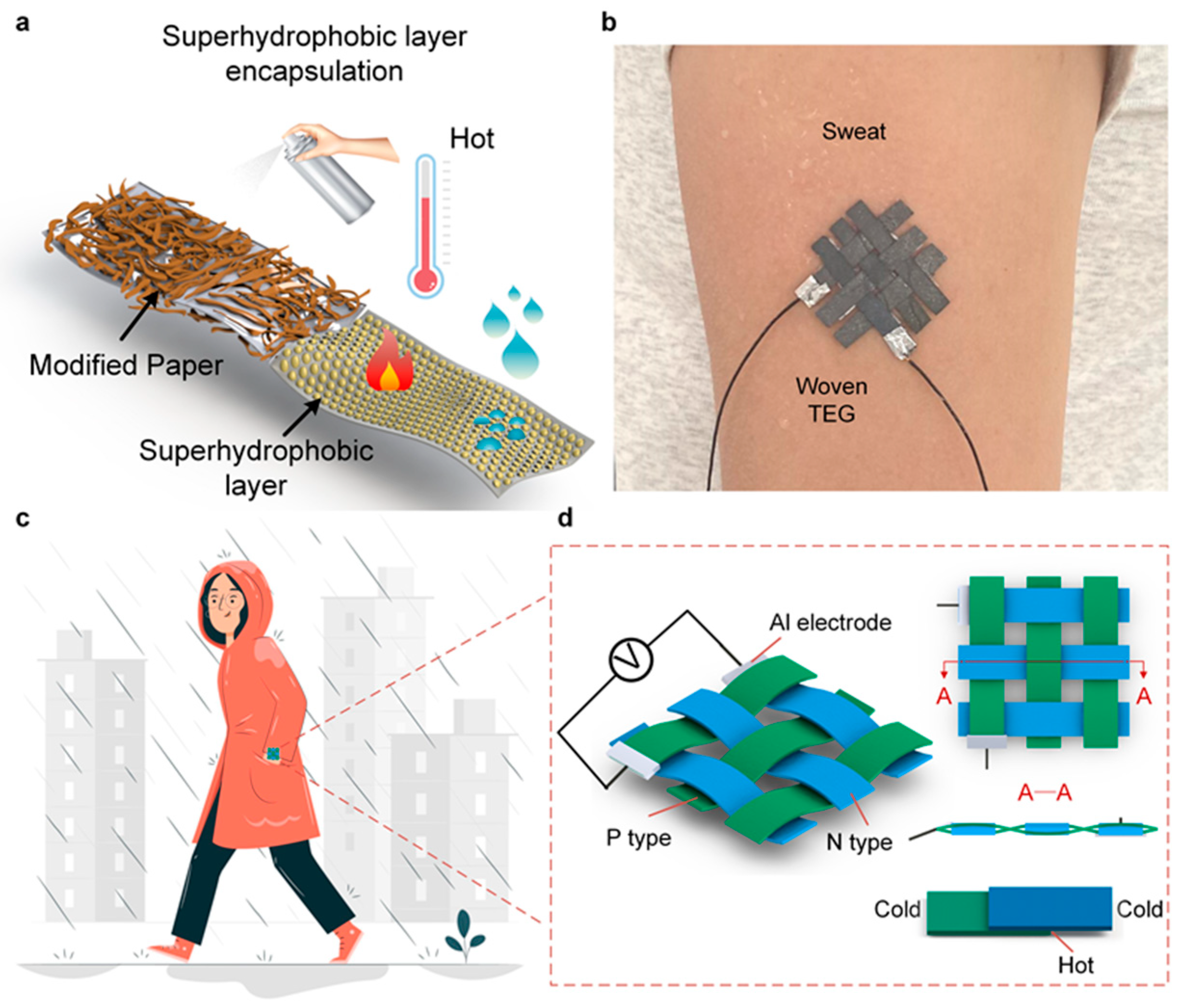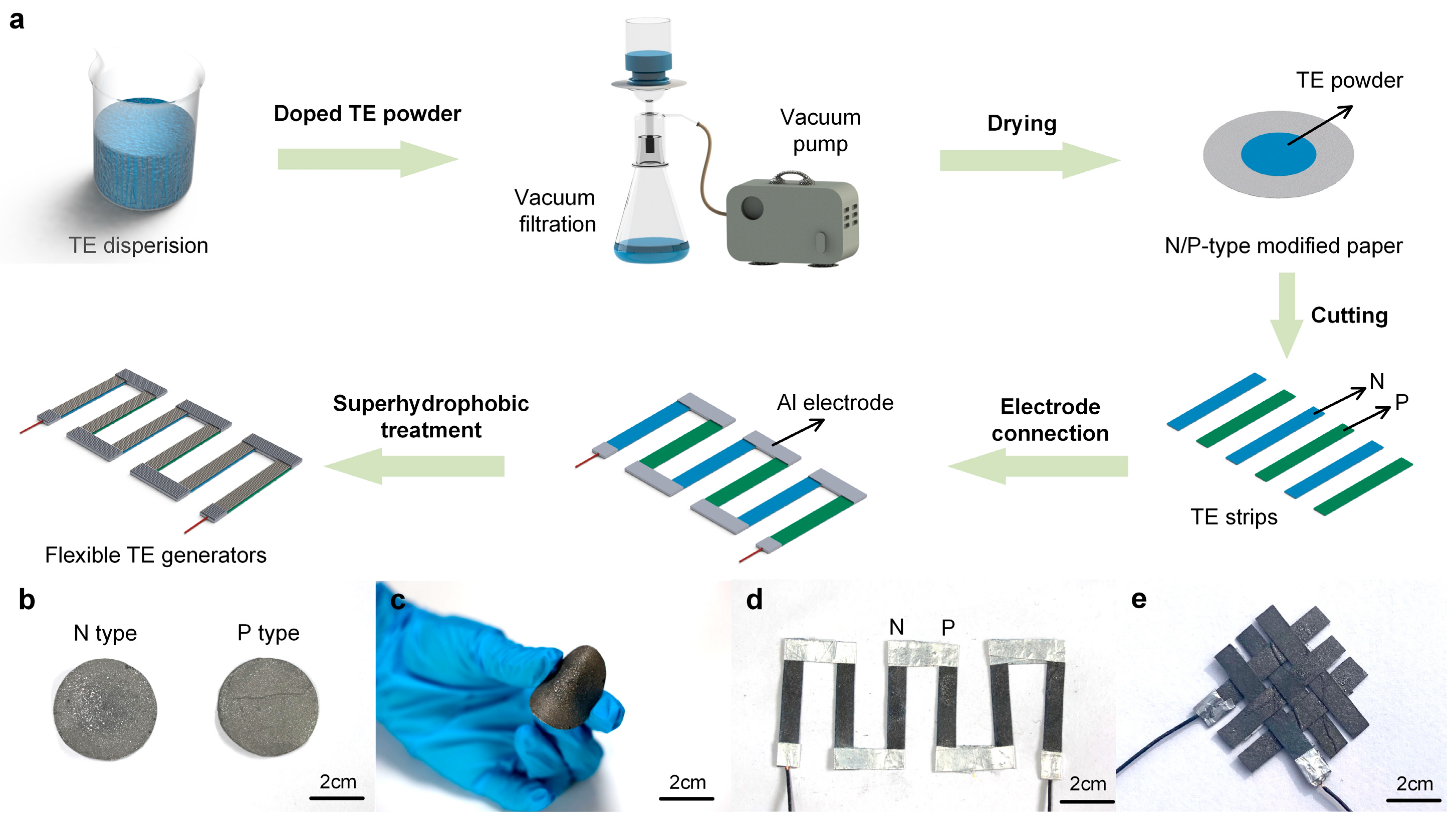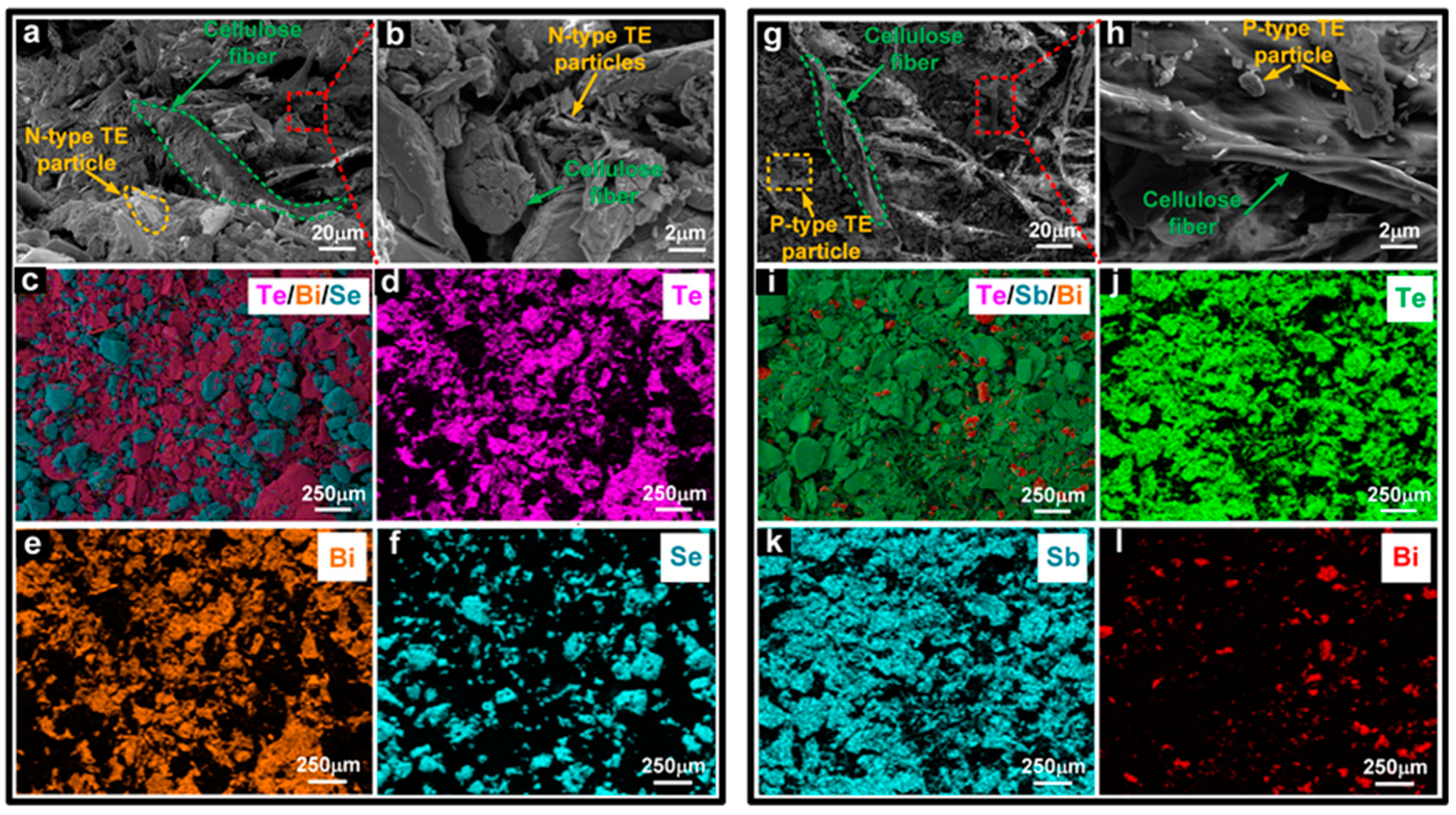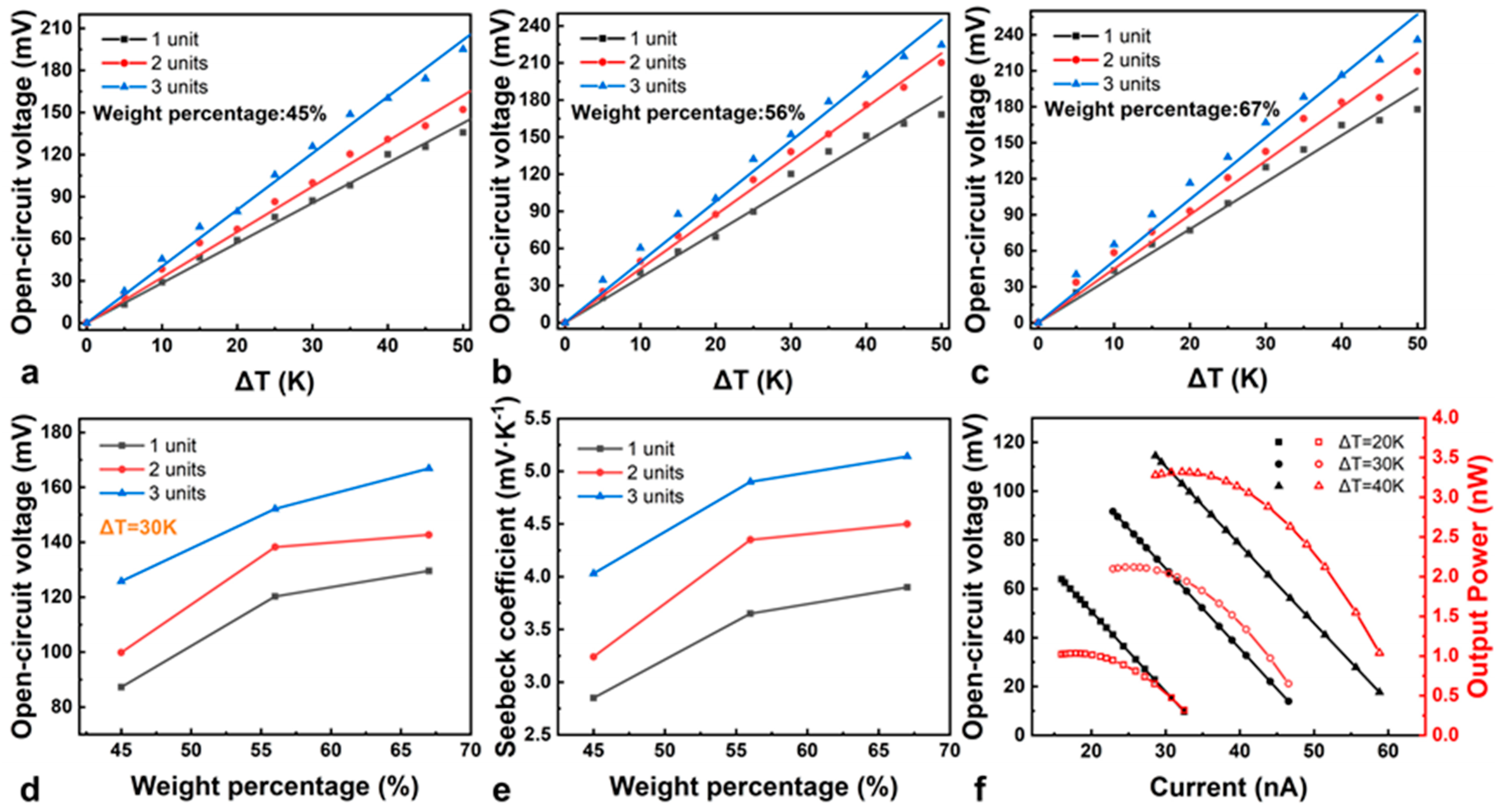A Waterproof Flexible Paper-Based Thermoelectric Generator for Humidity and Underwater Environments
Abstract
1. Introduction
2. Experimental Section
2.1. Materials
2.2. Preparation of TE-Modified Papers
2.3. Preparation of PTEGs and WPTEGs
2.4. Characterization and Testing
3. Results and Discussion
3.1. Preparation of PTEGs and WPTEGs
3.2. Characterization of Modified Cellulose Papers
3.3. Performance of the PTEGs
3.4. Characterization and Performance of the WPTEGs
3.5. Applications of the WPTEGs
4. Conclusions
Supplementary Materials
Author Contributions
Funding
Informed Consent Statement
Data Availability Statement
Acknowledgments
Conflicts of Interest
References
- Fu, Y.; Cheng, Y.; Wei, Q.; Zhao, Y.; Zhang, W.; Yang, Y.; Li, D. Multifunctional Biomass Composite Aerogel Co-modified by MXene and Ag Nanowires for Health Monitoring and Synergistic Antibacterial Applications. Appl. Surf. Sci. 2022, 598, 153783. [Google Scholar] [CrossRef]
- Martinez-Hernandez, U.; Firouzy, S.; Mehryar, P.; Meng, L.; Childs, C.; Buis, A.; Dehghani-Sanij, A.A. Human-in-the-loop Layered Architecture for Control of A Wearable Ankle–foot Robot. Robot. Auton. Syst. 2023, 161, 104353. [Google Scholar] [CrossRef]
- Tan, P.; Han, X.; Zou, Y.; Qu, X.; Xue, J.; Li, T.; Wang, Y.; Luo, R.; Cui, X.; Xi, Y.; et al. Self-Powered Gesture Recognition Wristband Enabled by Machine Learning for Full Keyboard and Multicommand Input. Adv. Mater. 2022, 34, 2200793. [Google Scholar] [CrossRef]
- Sarkar, A.; Shrotriya, P.; Chandra, A.; Hu, C. Chemo-economic Analysis of Battery Aging and Capacity Fade in Lithium-ion Battery. J. Energy Storage 2019, 25, 100911. [Google Scholar] [CrossRef]
- Klink, J.; Hebenbrock, A.; Grabow, J.; Orazov, N.; Nylén, U.; Benger, R.; Beck, H.-P. Comparison of Model-Based and Sensor-Based Detection of Thermal Runaway in Li-Ion Battery Modules for Automotive Application. Batteries 2022, 34, 8040034. [Google Scholar] [CrossRef]
- Ren, Z.; Zheng, Q.; Wang, H.; Guo, H.; Miao, L.; Wan, J.; Xu, C.; Cheng, S.; Zhang, H. Wearable and Self-cleaning Hybrid Energy Harvesting System Based on Micro/nanostructured Haze Film. Nano Energy 2020, 67, 104243. [Google Scholar] [CrossRef]
- Tang, Y.; Lei, Y.; Li, H.; Wu, Y.; Li, Y.; Liu, S.; Wang, H.; Liu, X. An Effective Oxygen Vacancy Restrain Method for Flexible Perovskite Solar Cells with Enhanced Performance and Bending Resistance. Appl. Surf. Sci. 2023, 641, 158416. [Google Scholar] [CrossRef]
- Li, J.; Zhao, C.; Xia, K.; Liu, X.; Li, D.; Han, J. Enhanced Piezoelectric Output of the PVDF-TrFE/ZnO Flexible Piezoelectric Nanogenerator by Surface Modification. Appl. Surf. Sci. 2019, 463, 626–634. [Google Scholar] [CrossRef]
- Zhao, Z.; Dai, Y.; Dou, S.X.; Liang, J. Flexible Nanogenerators for Wearable Electronic Applications Based on Piezoelectric Materials. Mater. Today Energy 2021, 20, 100690. [Google Scholar] [CrossRef]
- Jeon, Y.P.; Park, J.H.; Kim, T.W. Highly flexible Triboelectric Nanogenerators Fabricated Utilizing Active Layers with A ZnO Nanostructure on Polyethylene Naphthalate Substrates. Appl. Surf. Sci. 2019, 466, 210–214. [Google Scholar] [CrossRef]
- Yun, J.; Jayababu, N.; Kim, D. Self-powered Transparent and Flexible Touchpad Based on Triboelectricity Towards Artificial Intelligence. Nano Energy 2020, 78, 105325. [Google Scholar] [CrossRef]
- Lu, Y.; Li, X.; Cai, K.; Gao, M.; Zhao, W.; He, J.; Wei, P. Enhanced-Performance PEDOT:PSS/Cu2Se-Based Composite Films for Wearable Thermoelectric Power Generators. ACS Appl. Mater. Interfaces 2021, 13, 631–638. [Google Scholar] [CrossRef]
- Wang, Y.; Yang, L.; Shi, X.L.; Shi, X.; Chen, L.; Dargusch, M.S.; Zou, J.; Chen, Z.G. Flexible Thermoelectric Materials and Generators: Challenges and Innovations. Adv. Mater. 2019, 31, 1807916. [Google Scholar] [CrossRef] [PubMed]
- Pandiyarasan, V.; Suhasini, S.; Archana, J.; Navaneethan, M.; Majumdar, A.; Hayakawa, Y.; Ikeda, H. Fabrication of Hierarchical ZnO Nanostructures on Cotton Fabric for Wearable Device Applications. Appl. Surf. Sci. 2017, 418, 352–361. [Google Scholar] [CrossRef]
- Du, Y.; Chen, J.; Meng, Q.; Xu, J.; Paul, B.; Eklund, P. Flexible Ternary Carbon Black/Bi2Te3 based Alloy/polylactic Acid Thermoelectric Composites Fabricated by Additive Manufacturing. J. Mater. 2020, 6, 293–299. [Google Scholar] [CrossRef]
- Shi, T.; Chen, M.; Zhang, C.; Mao, Z.; Liang, J.; Liu, Z.; Zhang, J.; Zhang, Q.; Pan, L.; Wang, Y.; et al. Modifying Carbon Fiber Fabric for Flexible Thermoelectric Energy Conversion. Appl. Surf. Sci. 2023, 610, 155479. [Google Scholar] [CrossRef]
- Lin, Y.; Liu, J.; Wang, X.; Xu, J.; Liu, P.; Nie, G.; Liu, C.; Jiang, F. An Integral P-n Connected All-graphene Fiber Boosting Wearable Thermoelectric Energy Harvesting. Compos. Commun. 2019, 16, 79–83. [Google Scholar] [CrossRef]
- Zhang, Y.; Dai, Y.; Xia, F.; Zhang, X. Gelatin/polyacrylamide Ionic Conductive Hydrogel with Skin Temperature-triggered Adhesion for Human Motion Sensing and Body Heat Harvesting. Nano Energy 2022, 104, 107977. [Google Scholar] [CrossRef]
- Li, H.; Zong, Y.; Ding, Q.; Han, W.; Li, X. Paper-based Thermoelectric Generator Based on Multi-walled Carbon Nanotube/carboxylated Nanocellulose. J. Power Sources 2021, 500, 229992. [Google Scholar] [CrossRef]
- Kim, S.; Mo, J.-H.; Jang, K.-S. Solution-Processed Carbon Nanotube Buckypapers for Foldable Thermoelectric Generators. ACS Appl. Mater. Interfaces 2019, 11, 35675–35682. [Google Scholar] [CrossRef]
- Zhan, Z.; Lin, R.; Tran, V.-T.; An, J.; Wei, Y.; Du, H.; Tran, T.; Lu, W. Paper/Carbon Nanotube-Based Wearable Pressure Sensor for Physiological Signal Acquisition and Soft Robotic Skin. ACS Appl. Mater. Interfaces 2017, 9, 37921–37928. [Google Scholar] [CrossRef] [PubMed]
- Chen, S.; Song, Y.; Xu, F. Flexible and Highly Sensitive Resistive Pressure Sensor Based on Carbonized Crepe Paper with Corrugated Structure. ACS Appl. Mater. Interfaces 2018, 10, 34646–34654. [Google Scholar] [CrossRef]
- Karan, S.K.; Maiti, S.; Lee, J.H.; Mishra, Y.K.; Khatua, B.B.; Kim, J.K. Recent Advances in Self-powered Tribo-/piezoelectric Energy Harvesters: All-in-one Package for Puture Smart Technologies. Adv. Funct. Mater. 2020, 30, 2004446. [Google Scholar] [CrossRef]
- Sun, T.; Zhou, B.; Zheng, Q.; Wang, L.; Jiang, W. Stretchable fabric generates electric power from woven thermoelectric fibers. Nat. Commun. 2020, 11, 572. [Google Scholar] [CrossRef] [PubMed]
- Kumar, R.; Bhatt, R.; Tewary, A.; Debnath, A.; Bhatt, P.; Mani, N.; Jha, P.; Patro, P.; Bhattacharya, S.; Pathak, M. Synergistic Effect of Zn Doping on Thermoelectric Properties to Realize a High Figure-of-merit and Conversion Efficiency in Bi2−xZnxTe3 Based Thermoelectric Generators. J. Mater. Chem. C 2022, 10, 7970–7979. [Google Scholar] [CrossRef]
- Bae, E.J.; Kang, Y.H.; Jang, K.-S.; Lee, C.; Cho, S.Y. Solution Synthesis of Telluride-based Nano-barbell Structures Coated with PEDOT: PSS for Spray-printed Thermoelectric Generators. Nanoscale 2016, 8, 10885–10890. [Google Scholar] [CrossRef] [PubMed]
- Jin, R.; Chen, G.; Pei, J.; Sun, J.; Wang, Y. Controllable Synthesis and Electrochemical Hydrogen Storage Properties of Sb2Se3 Ultralong Nanobelts with Urchin-like Structures. Nanoscale 2011, 3, 3893–3899. [Google Scholar] [CrossRef] [PubMed]
- Zhang, C.; Li, Z.; Guo, Y.; Niu, X.; Liang, X.; Zhou, D.; Zhu, H.; Chen, J.; Mai, Y. Controllable Synthesis and Properties of Sb2Se3 Nanorods Synthesized by Hot-injection Method. J. Nanosci. Nanotechnol. 2017, 17, 1338–1344. [Google Scholar] [CrossRef] [PubMed]
- Yuan, Z.; Tang, X.; Xu, Z.; Li, J.; Chen, W.; Liu, K.; Liu, Y.; Zhang, Z. Screen-printed Radial Structure Micro Radioisotope Thermoelectric Generator. Appl. Energ. 2018, 225, 746–754. [Google Scholar] [CrossRef]
- Francioso, L.; De Pascali, C.; Farella, I.; Martucci, C.; Cretì, P.; Siciliano, P.; Perrone, A. Flexible Thermoelectric Generator for Ambient Assisted Living Wearable Biometric Sensors. J. Power Sources 2011, 196, 3239–3243. [Google Scholar] [CrossRef]
- Kim, S.J.; Choi, H.; Kim, Y.; We, J.H.; Shin, J.S.; Lee, H.E.; Oh, M.-W.; Lee, K.J.; Cho, B.J. Post Ionized Defect Engineering of The Screen-printed Bi2Te2.7Se0.3 Thick Film for High Performance Flexible Thermoelectric Generator. Nano Energy 2017, 31, 258–263. [Google Scholar] [CrossRef]
- Rojas, J.P.; Conchouso, D.; Arevalo, A.; Singh, D.; Foulds, I.G. Paper-based origami flexible and foldable thermoelectric nanogenerator. Nano Energy 2017, 31, 296–301. [Google Scholar] [CrossRef]
- Wang, Y.; Zhang, S.; Deng, Y. Flexible Low-grade Energy Utilization Devices Based on High-performance Thermoelectric Polyaniline/tellurium Nanorod Hybrid Films. J. Mater. Chem. A 2016, 4, 3554–3559. [Google Scholar] [CrossRef]
- Mulla, R.; Jones, D.R.; Dunnill, C.W. Thermoelectric Paper: Graphite Pencil Traces on Paper to Fabricate a Thermoelectric Generator. Adv. Mater. Technol. 2020, 5, 2000227. [Google Scholar] [CrossRef]
- Bae, E.J.; Kang, Y.H.; Lee, C. Engineered nanocarbon mixing for enhancing the thermoelectric properties of a telluride-PEDOT: PSS nanocomposite. J. Mater. Chem. A 2017, 5, 17867–17873. [Google Scholar] [CrossRef]
- Liang, L.; Wang, M.; Wang, X.; Peng, P.; Liu, Z. Initiating a stretchable, compressible, and wearable thermoelectric generator by a spiral architecture with ternary nanocomposites for efficient heat harvesting. Adv. Funct. Mater. 2022, 32, 2111435. [Google Scholar] [CrossRef]
- Li, Y.; Lou, Q.; Yang, J.; Cai, K.; Liu, Y.; Lu, Y. Exceptionally high power factor Ag2Se/Se/polypyrrole composite films for flexible thermoelectric generators. Adv. Funct. Mater. 2022, 32, 2106902. [Google Scholar] [CrossRef]
- Wang, Y.; Hong, M.; Liu, W.D.; Shi, X.L.; Xu, S.D. Bi0. 5Sb1. 5Te3/PEDOT: PSS-based flexible thermoelectric film and device. Chem. Eng. J. 2020, 397, 125360. [Google Scholar] [CrossRef]
- Lu, Y.; Qiu, Y.; Cai, K.; Li, X.; Gao, M.; Jiang, C. Ultrahigh performance PEDOT/Ag2Se/CuAgSe composite film for wearable thermoelectric power generators. Mater. Today Phys. 2020, 14, 100223. [Google Scholar] [CrossRef]
- Wang, Y.; Pang, H.; Guo, Q.; Tsujii, N.; Baba, T.; Baba, T. Flexible n-Type abundant chalcopyrite/PEDOT: PSS/graphene hybrid film for thermoelectric device utilizing low-grade heat. ACS Appl. Mater. Interfaces 2020, 13, 51245–51254. [Google Scholar]
- Mallick, M.M.; Rösch, A.G.; Franke, L.; Ahmed, S.; Gall, A.; Geßwein, H. High-performance Ag-Se-based n-type printed thermoelectric materials for high power density folded generators. ACS Appl. Mater. Interfaces 2020, 12, 19655–19663. [Google Scholar] [CrossRef] [PubMed]
- Zheng, C.; Xiang, L.; Jin, W.; Shen, H.; Zhao, W.; Zhang, F.; Di, C.A.; Zhu, D. A Flexible Self-powered Sensing Element with Integrated Organic Thermoelectric Generator. Adv. Mater. Technol. 2019, 4, 1900247. [Google Scholar] [CrossRef]







Disclaimer/Publisher’s Note: The statements, opinions and data contained in all publications are solely those of the individual author(s) and contributor(s) and not of MDPI and/or the editor(s). MDPI and/or the editor(s) disclaim responsibility for any injury to people or property resulting from any ideas, methods, instructions or products referred to in the content. |
© 2024 by the authors. Licensee MDPI, Basel, Switzerland. This article is an open access article distributed under the terms and conditions of the Creative Commons Attribution (CC BY) license (https://creativecommons.org/licenses/by/4.0/).
Share and Cite
Huang, Y.; Wang, W.; Chang, S.; Bao, A.; Liu, Y.; Li, R.; Xiong, J. A Waterproof Flexible Paper-Based Thermoelectric Generator for Humidity and Underwater Environments. Materials 2024, 17, 2338. https://doi.org/10.3390/ma17102338
Huang Y, Wang W, Chang S, Bao A, Liu Y, Li R, Xiong J. A Waterproof Flexible Paper-Based Thermoelectric Generator for Humidity and Underwater Environments. Materials. 2024; 17(10):2338. https://doi.org/10.3390/ma17102338
Chicago/Turabian StyleHuang, Yiduo, Wenfeng Wang, Sijia Chang, Aida Bao, Yuan Liu, Ruirui Li, and Jijun Xiong. 2024. "A Waterproof Flexible Paper-Based Thermoelectric Generator for Humidity and Underwater Environments" Materials 17, no. 10: 2338. https://doi.org/10.3390/ma17102338
APA StyleHuang, Y., Wang, W., Chang, S., Bao, A., Liu, Y., Li, R., & Xiong, J. (2024). A Waterproof Flexible Paper-Based Thermoelectric Generator for Humidity and Underwater Environments. Materials, 17(10), 2338. https://doi.org/10.3390/ma17102338





